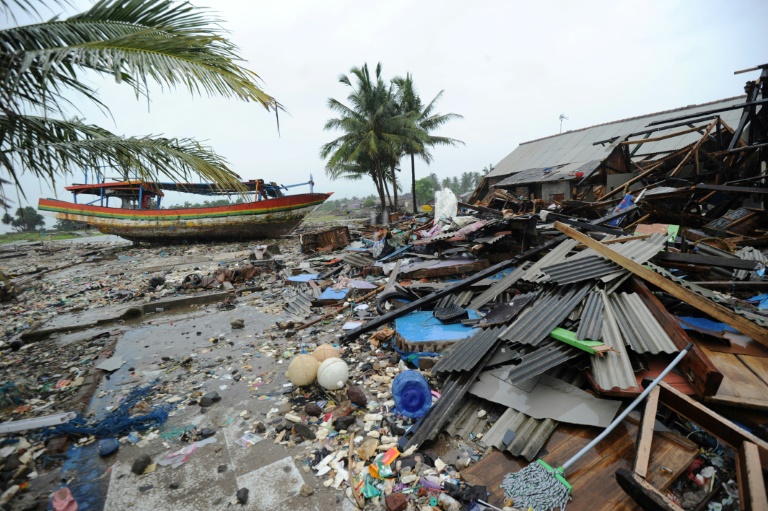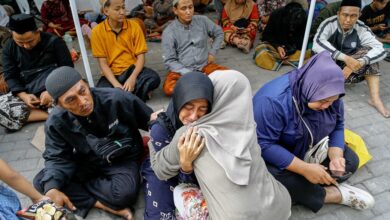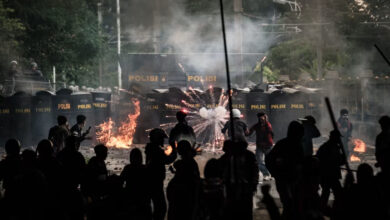
Indonesian search and rescue teams Wednesday plucked stranded residents from remote islands and pushed into isolated communities desperate for aid in the aftermath of a volcano-triggered tsunami that killed over 400.
But torrential rains hampered their efforts and heaped more misery on the region as stunned residents waded through waist-deep water in parts of hard-hit Carita.
“Heavy rains caused a river to overflow and several places are flooded,” national disaster agency spokesman Sutopo Purwo Nugroho said on Twitter.
“It’s hampering efforts to evacuate people and help other survivors.”
The disaster agency cautioned residents to stay clear of the coast as activity was still high at the rumbling Anak Krakatoa volcano, which sits in the middle of the Sunda Strait between Java and Sumatra islands.
A section of the crater collapsed after an eruption and slid into the ocean, triggering Saturday night’s killer tsunami, officials have said.
The powerful waves struck without warning, washing over popular beaches and inundating tourist hotels and coastal communities on both sides of the strait — and leaving a trail of death and destruction in its wake.
The latest death toll stood at 429, with 1,485 people injured and another 154 still missing.
Medical workers have warned that clean water and medicine supplies were running low — stoking fears of a public health crisis — as thousands of displaced survivors cram shelters and hospitals. Many were left homeless by the killer wave.
‘Devastation’
The disaster agency has dispatched helicopters to drop supplies into a handful of hard-to-reach communities along the shattered coastlines.
Hundreds of residents still stranded on tiny islands in Sunda Strait are being airlifted or taken by boat to shelters.
Sniffer dogs are being used to find those still missing as grief-stricken relatives lined up at identification centers.
But hopes of finding any survivors beneath the rubble have dwindled.
“We’re starting to access the most isolated places hit by the tsunami,” said senior disaster agency official Dody Ruswandi.
“The devastation there is pretty massive.”
Some roads and bridges near isolated communities had been damaged, making road access more difficult, he added.
At the Tanjung Lesung resort, mangled remnants were clumped on the soggy ground — a jumble of metal, chairs and awning.
Elsewhere, cars and minibuses had been thrown against buildings, concrete walls cracked into small pieces and uprooted trees spread around.
A wooden sign that read “Good Times” lay on the ground.
The tsunami struck the resort as more than 200 workers from the state electricity company were watching pop band Seventeen perform.
The four-member group was hurled from the stage as the water slammed into the audience — only the band’s lead vocalist survived.
‘Broken homes, broken bones’
Anak Krakatoa is an island that emerged in the crater left by Krakatoa, whose massive 1883 eruption killed at least 36,000 people.
Experts have warned that more deadly waves could slam the stricken region now covered by mountains of overturned cars, boats, furniture and other debris.
Many evacuees are too afraid to go home.
Hundreds of Indonesian Red Cross staff and volunteers are delivering clean water, blanket, tarpaulins and other supplies, while it dispatched mobile medical units.
“Our teams are seeing many broken bones and broken homes, and people who are very shaken,” said Arifin Hadi, head of disaster management at the Indonesian Red Cross.
“Indonesians have withstood a string of disasters this year and with them, so much loss and misery.”
The tsunami was Indonesia’s third major natural disaster in six months, following a series of powerful earthquakes on the island of Lombok in July and August and a quake-tsunami in September that killed around 2,200 people in Palu on Sulawesi island, with thousands more missing and presumed dead.
Jakarta has so far rebuffed offers of international aid, saying the disaster-prone country could handle the latest crisis.
On Wednesday, thousands prayed for loved ones at mass graves and mosques Wednesday to mark the 14th anniversary of the 2004 Boxing Day tsunami.
It was one of the deadliest disasters in history, killing some 220,000 people in countries around the Indian Ocean, including some 168,000 Indonesians, most in Aceh at the northern tip of Sumatra.
Indonesia, a vast Southeast Asian archipelago, is one of the most disaster-hit nations on Earth due to its position straddling the so-called Pacific Ring of Fire, where tectonic plates collide.




